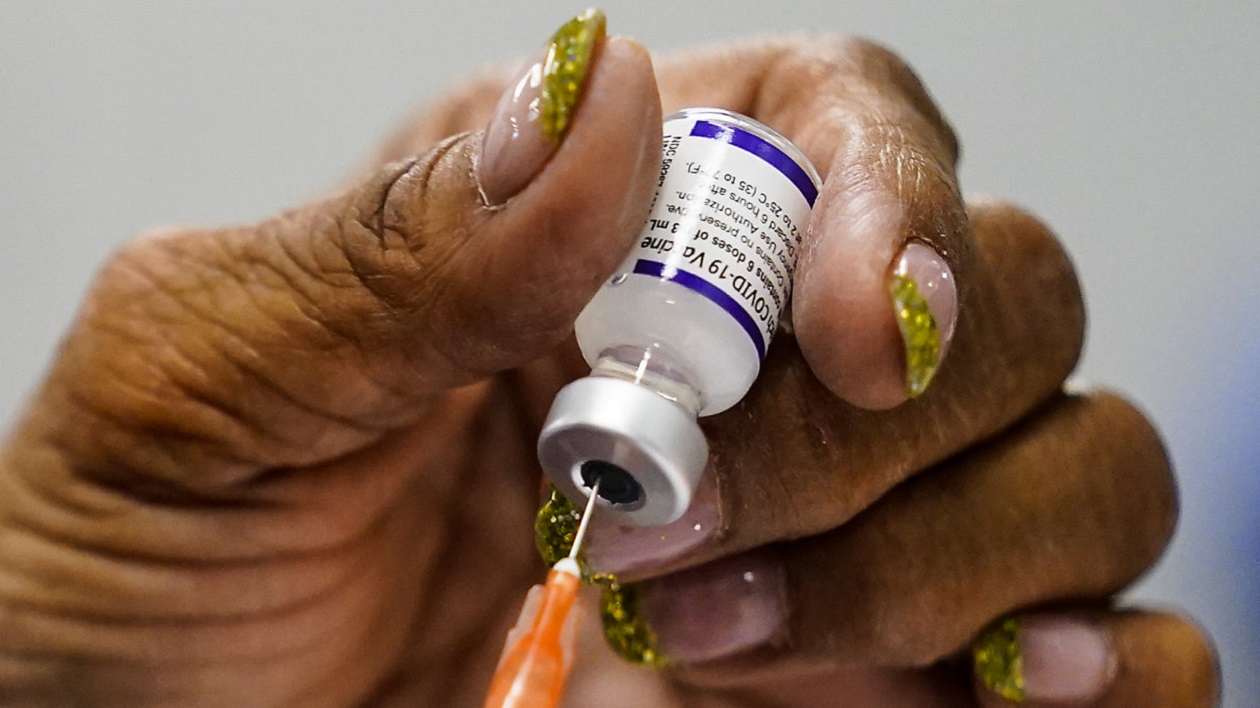
WASHINGTON–Is the coronavirus threat over? Evidence—disease figures and the rise of new variants—says “no.” Adding to the problem is the lack, thus far, of a strong government campaign against what is expected to be a resurgence of new forms of the virus this fall and GOP demands for cuts in funding for free booster shots and other anti-virus measures.
First a few figures. Though most U.S. coronavirus “dashboard” keepers stopped counting after Democratic President Joe Biden ended the national emergency about COVID-19 on May 13, the Geneva-based World Health Organization hasn’t. Its numbers are off, as some countries, now including the U.S., don’t send in reports.
But even the WHO admitted May 5 the coronavirus pandemic isn’t a world “public health emergency of international concern.” Instead, WHO now calls COVID-19 an “endemic” disease that keeps hanging around, mutating and mutating and never fully disappearing, just like the (misnamed) 1918 Spanish flu.
Still, WHO’s global figures are sobering: 770.44 million coronavirus (COVID-19) cases since the pandemic began, or about one-tenth of the world’s population. That includes 16,023 cases in the last seven days. And 6.957 million dead since late 2019.
And when WHO Director-General Tedros Adhanom Ghebreyesus made his welcome announcement that the disease has gone from being a pandemic to now being “endemic,” he cautioned the world wasn’t completely out of the woods. Coronavirus pandemic deaths globally “are still running at about 1,000 a week, and those are the deaths we know about,” he said.
U.S. numbers not in data base
While the U.S. numbers below are not in the WHO database, the U.S. Centers for Disease Control never stopped counting. It still gathers coronavirus (COVID-19) data, just not as comprehensively and not in as much detail as all dashboards did during the most disease-ridden days in the winter of 2020-21.
CDC reported new hospital admissions for COVID-19 and its variants hit a three-year weekly low on the week of June 24, 2023, of 6,315 nationwide. But by the week before Labor Day, hospital admissions almost tripled, however, to 17,418. Only 2% of hospitalized patients died, the same death rate, within a narrow range, for months. The all-time U.S. death rate high was 30% dead and 115,480 CIs the coronavirus threat over? Evidence and experts: ‘No,’ public: ‘yes.’ What’s going on here?
In the U.S., the figures were 103.44 million cases from the pandemic proclamation in March 2020 through Biden’s May 13 decision, and 1.127 million dead during the same time. That’s like killing everybody in Austin, Texas, and 150,000 more people in its suburbs.
Countermeasures: 13.5 trillion vaccine shots worldwide since the pandemic began, most of them boosters, of course. And 668.88 million of those shots, boosters included, were in U.S. arms.
The COVID outlook in the U.S. is skewed, too, for other reasons. There’s the next COVID variant, BA.2.86, and when and whether the vaccine will available to combat it.
And meanwhile, what to do about it.
The agency admits it’s learning as it goes, but the Centers for Disease Control is trying to keep up with the data. As of August 23, it found two cases in the U.S. and scattered ones elsewhere around the globe. CDC reports that as a mutation, BA.2.86 is as different, 37 times, from the second-generation COVID-19 variant, Omicron, as Omicron was from the original virus. The Delta variant was the first-generation coronavirus variant.
Nevertheless, the agency believes current vaccines will still protect people against BA.2.86. News reports indicate that new vaccines, created to attack it as well as other coronavirus mutations before BA.2.86, will work—when they hit the market. When that will be is to be determined by testing, CDC says. And there isn’t enough evidence, in available antibodies, to test, yet.
Nevertheless, a new booster will be available by the end of September, the agency predicts. And Dr. Anthony Fauci, the recently retired director of the National Institute for Allergies and Infectious Diseases—and the most credible voice on COVID—said on ABC’s This Week “it should be available to everyone” although CDC will recommend who gets top priority.
Meanwhile, if you feel like you have COVID, new or old, follow the same isolation, masking, testing and rest drills you did, and for the same time periods, when the plague raged, CDC urges. Of course, as CDC points out, this time you, rather than your insurer, may get stuck with the testing bill.
Wear your masks out in public, especially in crowds, even if doing so won’t be mandated anymore, Fauci added. Most people aren’t doing this.
“Virus samples are not yet broadly available for more reliable laboratory testing of antibodies,” against the latest mutation, “and it is too soon to know the real-world impacts on immunity,” CDC admits. “Nearly all the U.S. population has antibodies to” the coronavirus “from vaccination, previous infection, or both, and it is likely these antibodies will continue to provide some protection against severe disease from this variant.”
There is also Long COVID
There’s also “Long COVID,” using the official name for that ailment, which can last months or years. Neither the WHO nor the Centers for Disease Control has figured out an overall way to tackle it. And since it’s developed over time, and will continue to do so, counting it has become a problem, too.
“Long COVID is a wide range of new, returning, or ongoing health problems people experience after being infected” with the coronavirus, the CDC says. “Anyone who was infected can experience Long COVID. Most people with Long COVID experienced symptoms days after first learning they had COVID-19, but some people who later experienced Long COVID did not know when they [first] got infected.”
Long COVID symptoms include, but are not limited to fever, breathing problems, heart palpitations, “brain fog,” sleep problems, dizziness, chronic fatigue, depression, anxiety and diarrhea.
Certain groups are also more vulnerable to Long COVID, the center adds. They include COVID-19 survivors who were hospitalized or needed intensive care, those who had underlying health conditions, the unvaccinated, and those who “because of where they live or work…can’t get health care.
“Health inequities may put some people from racial or ethnic minority groups and some people with disabilities at greater risk for developing Long COVID,” CDC drily says.
Much of the public isn’t waiting for the government, the new booster or anything else, to believe the modern-day plague is over and done with, according to the Gallup Poll. The poll, published June 28, reported people, by 64%-36%, believed the pandemic was over. It was the first time since the coronavirus pandemic hit that more than half of the public felt that way. At the prior poll on the subject, in February, 49% said it was over.
The June survey’s “plague is over” numbers included 51% of Democrats, almost double the optimistic share from February (28%). Republican and independent optimism grew, too, by smaller margins. Their reason? Overall, only 2% “are very worried” they’ll catch the disease in the future, compared to 16% somewhat worried, 36% not too worried and almost half (46%) who aren’t worried at all.
There also seems to be bipartisan positivity, as 71% of the Republicans saying they won’t catch the virus, while 29% combined fall into the other three categories. The Democratic splits: 29% not worried at all and 45% not too worried.
Gallup explains that attitude as the result of ending the national emergency and relaxation of various anti-plague measures. But glee over being “safe” doesn’t translate into normalcy, though. A bare plurality, 43%-41%, believe the nation will ever return to a “pre-pandemic normal.” The rest are undecided. The implication is the nation will have a “new normal,” but Gallup didn’t ask them what it would be.
As usual, right-wing Republicans always seem to make combatting any disease, pandemic or endemic, more difficult than it would be without their input. They continue to attack the CDC, for example, claiming that any talk of the need to continue fighting the virus is tantamount to Democratic desires to “control” the population and put an end to “freedom.”
Maybe, though no one brought up the point to Gallup, voters can ask the presidential contenders what they think the “new normal” should be regarding the coronavirus.
Still, two infectious disease epidemiologists urged caution in interviews with the medical journal Stat. Both Cecile Viboud of the National Institutes of Health and Mark Lipsitch of the Harvard School of Public Health spoke just before the World Health Organization ended the global emergency.
Never dealt with this
Viboud explained the U.S. and the world had never dealt with this type of worldwide pandemic before, so what she had to go on was the aftermath of prior international flu pandemics, notably the one of 1918. It lingered for four years. Mutants of that Spanish flu are one reason for your flu shots for every autumn.
“We’re in that slow transition phase,” with the coronavirus, Viboud said.
How the coronavirus pandemic eventually ends, or what it morphs into, might be very unlike the flu’s aftermath, too. “These three years have taught us that you have to remain humble and realize that there might be something that you haven’t thought about, and it could be completely different than you believed,” Viboud said.
“COVID isn’t going anywhere” even though it’s now less damaging to humankind, Lipsitch said.
“The death toll is going down and the ability of society to function is going up.” But since virus will still be around, just like the flu is, “there is no actual end to point to,” he added. It might become “more predictable and less dangerous” as human immunity adapts.
What neither Lipsitch nor Viboud could predict—and what Gallup didn’t ask—is what happens if the virus roars back. In other words, will we freak out at a return to the dismal days and nights of isolation, burnt-out nurses, overcrowded wards, and helpless loved ones watching lives ebb away to contagion. Not to mention jobs lost, stores closed, depression, suicides and people lined up in their cars for food.
“Epidemiologists and medical historians look for signs the virus is transitioning into something that is more predictable and less dangerous. That’s a journey whose timing is influenced by both how the virus evolves and how quickly our immune systems acquire the capacity to cope with the new disease,” Lipsitch told the journal.
So now we have the next COVID variant, BA.2.86, and when and the issue of whether the vaccine will available to combat it.
We hope you appreciated this article. At People’s World, we believe news and information should be free and accessible to all, but we need your help. Our journalism is free of corporate influence and paywalls because we are totally reader-supported. Only you, our readers and supporters, make this possible. If you enjoy reading People’s World and the stories we bring you, please support our work by donating or becoming a monthly sustainer today. Thank you!












Comments